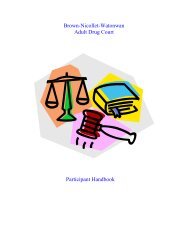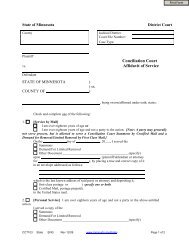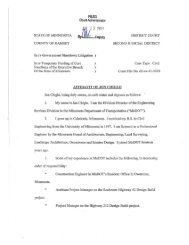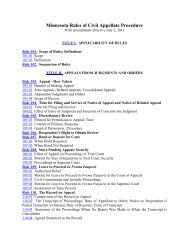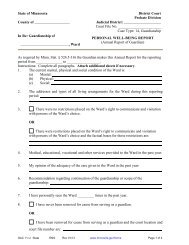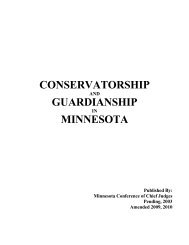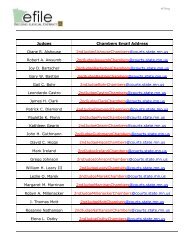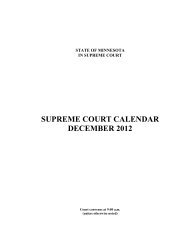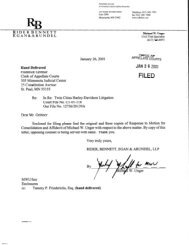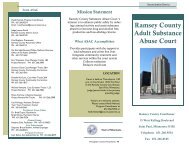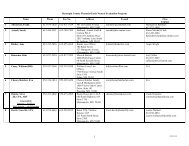1989-03-24 Comments of Star Tribune.pdf - Minnesota Judicial Branch
1989-03-24 Comments of Star Tribune.pdf - Minnesota Judicial Branch
1989-03-24 Comments of Star Tribune.pdf - Minnesota Judicial Branch
You also want an ePaper? Increase the reach of your titles
YUMPU automatically turns print PDFs into web optimized ePapers that Google loves.
19% REPORT TO THE GOVERNOR AND THE LEGISLATURE 25<br />
The reportedso surveyed participant attitudes to- against the general negative to neutral attitude to-<br />
,,.ard audiov%uaI media coverage. Judges, witnesses ward permitting cameras in the courtroom.=<br />
and jurors found the presence <strong>of</strong>.cameras and audio The report ended by cautioning against granting<br />
,quipment acceptable by approxunately two to one, unrestricted courtroom access to the media because<br />
while attorneys were approximately three to two in the study experience took place in a highly S~II.Kopposition.<br />
s The latter figure must be viewed tured and tightly controlled environment.n<br />
The special committee met on October 15,1981, to<br />
consider the consultant’s report. After discussing the<br />
consu]tam’s findings and recommendations, the<br />
comdttee voted to recommend, with two members<br />
dissenting, that the <strong>Judicial</strong> COLUIC~~ repeal rule 980,<br />
<strong>of</strong>fecuve January 1, 1982, and substitute in its place<br />
the wording <strong>of</strong> rule 989.2 with the changes noted<br />
below. The committee also recommended, with one<br />
member dissenting and one member abstaining, that<br />
the consultant’s report be “accepted as responding to<br />
the inquiry <strong>of</strong> the <strong>Judicial</strong> Council.”<br />
The committee also recommended that the Judi-<br />
cial Council:<br />
1. Eliminate the shutter noise problem by requir-<br />
ing the use <strong>of</strong> “blimps” on all still cameras except<br />
Leica M42 Rangefinder cameras (one member dis-<br />
scnted).<br />
2. Prohibit any close-range photographs <strong>of</strong> jurors,<br />
particularly front or side face shots (three members<br />
dissented).<br />
3. Continue the requirement <strong>of</strong> a written request<br />
for permission to conduct film or electronic media<br />
coverage (one member dissented).<br />
4. Retain the requirement that audio-visual media<br />
coverage be permitted only on the consent <strong>of</strong> the<br />
judge (two members dissented).<br />
5. Reject the consultant’s suggestion that relaxa-<br />
tion <strong>of</strong> certain <strong>of</strong> the rules be permitted in the discre-<br />
tion <strong>of</strong> the court with reasons stated on the record.<br />
At’ the November 14, 1981 <strong>Judicial</strong> Council meet-<br />
ing, the council directed staff to (1) seek comment<br />
IV. EXPERIMENTAL RULE ADOPTED<br />
V. PERMANENT RULE ADOPTED<br />
on the desirability <strong>of</strong> amending the rules to permit<br />
coverage <strong>of</strong> court proceedings by the film and electronic<br />
media after the experiment ends, and on the<br />
form and content <strong>of</strong> the rules under which a permanent<br />
system should function, and (2) explore ways <strong>of</strong><br />
expanding the consultant’s data on the effect <strong>of</strong> cameras<br />
on witnesses and jurors, and report to the spring,<br />
1982, meeting <strong>of</strong> the council.” The council also extended<br />
the expiration date <strong>of</strong> the experimental rules<br />
to December 31, 1982.<br />
At the May 15, 1982 meeting, a status report on<br />
witness and juror information was presented CO the<br />
councikg At that time it was reported that staff<br />
would send a letter to each attorney appearing in a<br />
media-covered case asking whether there were any<br />
problems with witnesses or jurors because <strong>of</strong> media<br />
presence. The letters were subsequently sent and<br />
the responses summarized and presented to the<br />
council at its November 20.1982, meeting.<br />
At the same time, the council was informed <strong>of</strong> a<br />
study being planned by the State Bar on the effect <strong>of</strong><br />
film and electronic media coverage on witnesses and<br />
jurors. The State Bar Committee on Administration<br />
<strong>of</strong> Justice was discussing what action, if any, should be<br />
recommended to the Board <strong>of</strong> Governors.” Largely<br />
to await the results <strong>of</strong> that study, and to allow further<br />
evaluation <strong>of</strong> comments received, the council extended<br />
the expiration date <strong>of</strong> the experiment to December<br />
31, 1983. The State Bar was unable to find<br />
funding for the study.<br />
At its November 19,1983 meeting, the council au- (1) “Film or electronic media coverage” means<br />
thorized the circulation for comment <strong>of</strong> the text <strong>of</strong> a any recording or broadcasting <strong>of</strong> court proceedings<br />
draft permanent rule permitting film and electronic by the media using television, radio, photographic, or<br />
media coverage <strong>of</strong> courtroom proceedings. The expi- recording equipment.<br />
ration date <strong>of</strong> the experimental rules was extended to (2) “Media” or “media agency” means any person<br />
June 30,1984, to allow time for comment on the draft or organization engaging in news gathering or report-<br />
permanent rule.” ing and includes any newspaper, radio or television<br />
The text and a summary <strong>of</strong> the draft permanent station or network, news service, magazine, trade pa-<br />
rule were widely distributed and comments were per, in-house publication, pr<strong>of</strong>essional journal, or<br />
invited. other news reporting or news gathering agency.<br />
The <strong>Judicial</strong> Council adopted the permanent rule (b) [Media coverage] Film or electronic media<br />
on June 1,1984. The text <strong>of</strong> the rule, which took effect coverage is permitted only on written order <strong>of</strong> the<br />
one month later. follows: court. The court may refuse, limit or terminate film<br />
Rule 980. Photographing, recording, and broad-<br />
casting in the courtroom<br />
(a) [Definitions] I<br />
or electronic media coverage in the interests <strong>of</strong> jus-<br />
tice to protect the rights <strong>of</strong> the parties and the dignity<br />
<strong>of</strong> the court, or to assure the orderly conduct <strong>of</strong> the<br />
proceedings. This rule does not otherwise limit or



